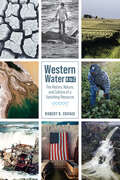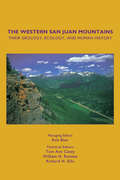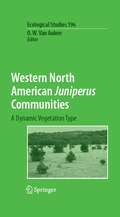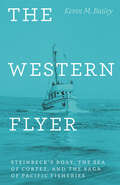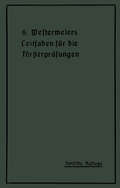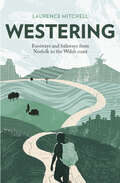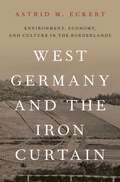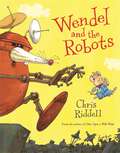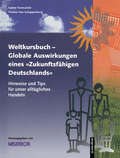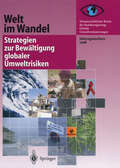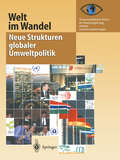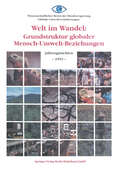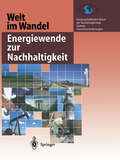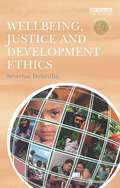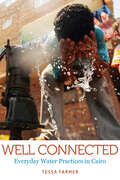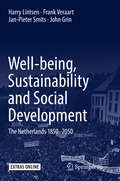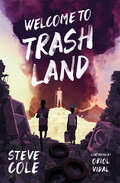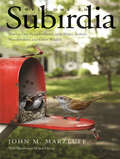- Table View
- List View
Western Water A to Z: The History, Nature, and Culture of a Vanishing Resource
by Robert R. CrifasiWestern Water A to Z is the first ever field guide to Western water. Reinventing this twentieth-century genre for a twenty-first-century audience, Robert R. Crifasi answers questions about rivers, water projects, the culture of water, the ecosystems water projects have created or destroyed, and the reliance of cities, farms, and industries on this critical resource. Organized as a collection of terms, the book addresses the most salient water issues and provides helpful background information regarding their origins and implications. Photographs serve a vital role in the cultural dialogue on water and stand as an equal partner to the text. Each subject is covered in about one page and is accompanied by one or two striking images from famous photographers like Margaret Bourke-White, Carleton E. Watkins, Arthur Rothstein, William Henry Jackson, and Dorothea Lang as well as Crifasi’s own work. Water often finds itself at the center of our cultural discourse in art, cinema, and literature, which play essential roles in shaping our understanding and experience of Western water. Crifasi also engages personalities that are nearly synonymous with Western water—John Wesley Powell, Elwood Mead, and Floyd Dominy, among others—to show how their lives intertwined with and often influenced the course of water development across the region. Travelers, adventurers, students, and anyone interested in water will find Western Water A to Z a handy and entertaining reference guide.
The Western San Juan Mountains: Their Geology, Ecology, and Human History
by Rob Blair Tom Ann Casey William H. Romme Richard N. EllisThe San Juan Skyway winds its way up, over, and through canyons, mesas, plateaus, mountains, plains, and valleys. The sheer variety of landforms makes the Skyway a veritable classroom for the amateur naturalist and historian. The most complete work published on the natural history of southwest Colorado's majestic mountain system, The Western San Juan Mountains: Their Geology, Ecology, and Human History is designed to be used while exploring the scenic 235-mile paved San Juan Skyway, which passes through Durango, Silverton, Ouray, Telluride, Dolores, and Cortez. The Western San Juan Mountains covers the physical environment, the biological communities, the human history, and points of interest represented on milepost signs along the highway. Some of the many topics covered include: how the San Juan Mountains were formed; why the landscape is so rugged and picturesque; why the vegetation changes from the lowlands to the alpine heights; energy and mineral resources of the area; why these mountains intrigued early explorers; factors that influence the unpredictable weather; and the first-known inhabitants. The contributions to this guide include Fort Lewis College geologists, biologists, archaeologists, historians, and other specialists. Together they have amassed more than one hundred years of study based not only on previous work but on their own research. This generously illustrated guidebook is aimed at all those who wish to understand this intricate mountain system in much greater detail than provided by most picture books.
Western North American Juniperus Communities: A Dynamic Vegetation Type (Ecological Studies #196)
by Oscar Van AukenIn North America, Juniperus woodlands occupy approximately 55 million hectares, an area larger than the state of Texas. This title addresses various aspects of the biology, ecology, and management of Juniperus woodlands and savannas, synthesizing past and current research findings as well as proposed research. The book provides ecologists, land managers, and foresters with a solid foundation in Juniperus ecosystems, enabling them to manage the communities for maximum sustained productivity and diversity.
The Western Flyer: Steinbeck's Boat, the Sea of Cortez, and the Saga of Pacific Fisheries
by Kevin M. BaileyIn January 2010, the Gemini was moored in the Swinomish Slough on a Native American reservation near Anacortes, Washington. Unbeknownst to almost everyone, the rusted and dilapidated boat was in fact the most famous fishing vessel ever to have sailed: the original Western Flyer, immortalized in John Steinbeck’s nonfiction classic The Log from the Sea of Cortez. In this book, Kevin M. Bailey resurrects this forgotten witness to the changing tides of Pacific fisheries. He draws on the Steinbeck archives, interviews with family members of crew, and more than three decades of working in Pacific Northwest fisheries to trace the depletion of marine life through the voyages of a single ship. After Steinbeck and his friend Ed Ricketts—a pioneer in the study of the West Coast’s diverse sea life and the inspiration behind “Doc” in Cannery Row—chartered the boat for their now-famous 1940 expedition, the Western Flyer returned to its life as a sardine seiner in California. But when the sardine fishery in Monterey collapsed, the boat moved on: fishing for Pacific ocean perch off Washington, king crab in the Bering Sea off Alaska, and finally wild Pacific salmon—all industries that would also face collapse. As the Western Flyer herself faces an uncertain future—a businessman has bought her, intending to bring the boat to Salinas, California, and turn it into a restaurant feature just blocks from Steinbeck’s grave—debates about the status of the California sardine, and of West Coast fisheries generally, have resurfaced. A compelling and timely tale of a boat and the people it carried, of fisheries exploited, and of fortunes won and lost, The Western Flyer is environmental history at its best: a journey through time and across the sea, charting the ebb and flow of the cobalt waters of the Pacific coast.
The Western Flyer: Steinbeck's Boat, the Sea of Cortez, and the Saga of Pacific Fisheries
by Kevin M. BaileyIn January 2010, the Gemini was moored in the Swinomish Slough on a Native American reservation near Anacortes, Washington. Unbeknownst to almost everyone, the rusted and dilapidated boat was in fact the most famous fishing vessel ever to have sailed: the original Western Flyer, immortalized in John Steinbeck’s nonfiction classic The Log from the Sea of Cortez. In this book, Kevin M. Bailey resurrects this forgotten witness to the changing tides of Pacific fisheries. He draws on the Steinbeck archives, interviews with family members of crew, and more than three decades of working in Pacific Northwest fisheries to trace the depletion of marine life through the voyages of a single ship. After Steinbeck and his friend Ed Ricketts—a pioneer in the study of the West Coast’s diverse sea life and the inspiration behind “Doc” in Cannery Row—chartered the boat for their now-famous 1940 expedition, the Western Flyer returned to its life as a sardine seiner in California. But when the sardine fishery in Monterey collapsed, the boat moved on: fishing for Pacific ocean perch off Washington, king crab in the Bering Sea off Alaska, and finally wild Pacific salmon—all industries that would also face collapse. As the Western Flyer herself faces an uncertain future—a businessman has bought her, intending to bring the boat to Salinas, California, and turn it into a restaurant feature just blocks from Steinbeck’s grave—debates about the status of the California sardine, and of West Coast fisheries generally, have resurfaced. A compelling and timely tale of a boat and the people it carried, of fisheries exploited, and of fortunes won and lost, The Western Flyer is environmental history at its best: a journey through time and across the sea, charting the ebb and flow of the cobalt waters of the Pacific coast.
The Western Flyer: Steinbeck's Boat, the Sea of Cortez, and the Saga of Pacific Fisheries
by Kevin M. BaileyIn January 2010, the Gemini was moored in the Swinomish Slough on a Native American reservation near Anacortes, Washington. Unbeknownst to almost everyone, the rusted and dilapidated boat was in fact the most famous fishing vessel ever to have sailed: the original Western Flyer, immortalized in John Steinbeck’s nonfiction classic The Log from the Sea of Cortez. In this book, Kevin M. Bailey resurrects this forgotten witness to the changing tides of Pacific fisheries. He draws on the Steinbeck archives, interviews with family members of crew, and more than three decades of working in Pacific Northwest fisheries to trace the depletion of marine life through the voyages of a single ship. After Steinbeck and his friend Ed Ricketts—a pioneer in the study of the West Coast’s diverse sea life and the inspiration behind “Doc” in Cannery Row—chartered the boat for their now-famous 1940 expedition, the Western Flyer returned to its life as a sardine seiner in California. But when the sardine fishery in Monterey collapsed, the boat moved on: fishing for Pacific ocean perch off Washington, king crab in the Bering Sea off Alaska, and finally wild Pacific salmon—all industries that would also face collapse. As the Western Flyer herself faces an uncertain future—a businessman has bought her, intending to bring the boat to Salinas, California, and turn it into a restaurant feature just blocks from Steinbeck’s grave—debates about the status of the California sardine, and of West Coast fisheries generally, have resurfaced. A compelling and timely tale of a boat and the people it carried, of fisheries exploited, and of fortunes won and lost, The Western Flyer is environmental history at its best: a journey through time and across the sea, charting the ebb and flow of the cobalt waters of the Pacific coast.
The Western Flyer: Steinbeck's Boat, the Sea of Cortez, and the Saga of Pacific Fisheries
by Kevin M. BaileyIn January 2010, the Gemini was moored in the Swinomish Slough on a Native American reservation near Anacortes, Washington. Unbeknownst to almost everyone, the rusted and dilapidated boat was in fact the most famous fishing vessel ever to have sailed: the original Western Flyer, immortalized in John Steinbeck’s nonfiction classic The Log from the Sea of Cortez. In this book, Kevin M. Bailey resurrects this forgotten witness to the changing tides of Pacific fisheries. He draws on the Steinbeck archives, interviews with family members of crew, and more than three decades of working in Pacific Northwest fisheries to trace the depletion of marine life through the voyages of a single ship. After Steinbeck and his friend Ed Ricketts—a pioneer in the study of the West Coast’s diverse sea life and the inspiration behind “Doc” in Cannery Row—chartered the boat for their now-famous 1940 expedition, the Western Flyer returned to its life as a sardine seiner in California. But when the sardine fishery in Monterey collapsed, the boat moved on: fishing for Pacific ocean perch off Washington, king crab in the Bering Sea off Alaska, and finally wild Pacific salmon—all industries that would also face collapse. As the Western Flyer herself faces an uncertain future—a businessman has bought her, intending to bring the boat to Salinas, California, and turn it into a restaurant feature just blocks from Steinbeck’s grave—debates about the status of the California sardine, and of West Coast fisheries generally, have resurfaced. A compelling and timely tale of a boat and the people it carried, of fisheries exploited, and of fortunes won and lost, The Western Flyer is environmental history at its best: a journey through time and across the sea, charting the ebb and flow of the cobalt waters of the Pacific coast.
Westermeiers Leitfaden für die Försterprüfungen
by H. MüllerDieser Buchtitel ist Teil des Digitalisierungsprojekts Springer Book Archives mit Publikationen, die seit den Anfängen des Verlags von 1842 erschienen sind. Der Verlag stellt mit diesem Archiv Quellen für die historische wie auch die disziplingeschichtliche Forschung zur Verfügung, die jeweils im historischen Kontext betrachtet werden müssen. Dieser Titel erschien in der Zeit vor 1945 und wird daher in seiner zeittypischen politisch-ideologischen Ausrichtung vom Verlag nicht beworben.
Westering: Footways and folkways from Norfolk to the Welsh coast
by Laurence MitchellFrom Great Yarmouth to Aberystwyth, Westering is a coast-to-coast journey crossing the Fens, Leicester, the Black Country and central Wales. It connects landscape, place and memory to evoke a narrative unravelling the deep topography, and following a westerly route that runs against the grain of the land, its geology, culture and historical bedrock.With the industrial Midlands sandwiched between bucolic landscapes in East Anglia and Wales, here we explore places too often overlooked. Along the way we encounter deserted medieval villages, battlefield sites, the ghosts of Roman soldiers, valleys drowned for reservoirs, ancient forests, John Clare’s beloved fields, and the urban edgelands.Notions of home and belonging, landscapes of loss and absence, birds and the resilience of nature, the psychology of walking, and the psychogeography of liminal places all frame the story.
WEST GERMANY & THE IRON CURTAIN C: Environment, Economy, and Culture in the Borderlands
by Astrid M. EckertWest Germany and the Iron Curtain takes a fresh look at the history of Cold War Germany and the German reunification process from the spatial perspective of the West German borderlands that emerged along the volatile inter-German border after 1945. These border regions constituted the Federal Republic's most sensitive geographical space where it had to confront partition and engage its socialist neighbor East Germany in concrete ways. Each issue that arose in these borderlands - from economic deficiencies, border tourism, environmental pollution, landscape change, and the siting decision for a major nuclear facility - was magnified and mediated by the presence of what became the most militarized border of its day, the Iron Curtain. In topical chapters, the book addresses the economic consequences of the border for West Germany, which defined the border regions as depressed areas, and examines the cultural practice of western tourism to the Iron Curtain. At the heart of this deeply-researched book stands an environmental history of the Iron Curtain that explores transboundary pollution, landscape change, and a planned nuclear industrial site at Gorleben that was meant to bring jobs into the depressed border regions. The book traces these subjects across the caesura of 1989/90, thereby integrating the "long" postwar era with the post-unification decades. As Eckert demonstrates, the borderlands that emerged with partition and disappeared with reunification did not merely mirror some larger developments in the Federal Republic's history but actually helped to shape them.
West Germany and the Iron Curtain: Environment, Economy, and Culture in the Borderlands
by Astrid M. EckertWest Germany and the Iron Curtain takes a fresh look at the history of Cold War Germany and the German reunification process from the spatial perspective of the West German borderlands that emerged along the volatile inter-German border after 1945. These border regions constituted the Federal Republic's most sensitive geographical space where it had to confront partition and engage its socialist neighbor East Germany in concrete ways. Each issue that arose in these borderlands - from economic deficiencies, border tourism, environmental pollution, landscape change, and the siting decision for a major nuclear facility - was magnified and mediated by the presence of what became the most militarized border of its day, the Iron Curtain. In topical chapters, the book addresses the economic consequences of the border for West Germany, which defined the border regions as depressed areas, and examines the cultural practice of western tourism to the Iron Curtain. At the heart of this deeply-researched book stands an environmental history of the Iron Curtain that explores transboundary pollution, landscape change, and a planned nuclear industrial site at Gorleben that was meant to bring jobs into the depressed border regions. The book traces these subjects across the caesura of 1989/90, thereby integrating the "long" postwar era with the post-unification decades. As Eckert demonstrates, the borderlands that emerged with partition and disappeared with reunification did not merely mirror some larger developments in the Federal Republic's history but actually helped to shape them.
Wendel and the Robots
by Chris RiddellA brilliantly funny robot adventure from award-winning author and illustrator, Chris Riddell, creator of Once Upon a Wild Wood.Wendel is a very clever mouse – but not a very tidy one. If his inventions go wrong, Wendel just throws them away and starts again. So when Clunk, his robot assistant, fills the sock drawer with cups and saucers and makes tea in a Wellington boot, Wendel throws him on the scrapheap and makes himself a new assistant: the Wendelbot. But he gets more than he bargained for, and soon Wendel finds himself on the scrapheap. Can he win back his workshop from the mighty Wendelbot? Let the robot battle commence!With Chris Riddell's characteristic verve and brilliance, Wendel and the Robots is a wonderfully funny, action-packed story full of surprises and extraordinary inventions, and with a subtle environmental message.
Weltkursbuch-Globale Auswirkungen eines „Zukunftsfähigen Deutschlands“: Hinweise und Tips für unser alltägliches Handeln
by MisereorMISEREOR soll die Armen der Dritten Welt unterstützen -warum mischt es sich dann in die Diskussionen um ein zukunftsfähiges Deutschland ein? Die Kritik ist schnell und plakativ formuliert: Misereor ist für die Armen der Dritten Welt da. Diesen notleidenden Menschen soll das Werk konkret hel fen. Wenn Misereor sich statt dessen mit Fragen eines zukunftsfähigen Deutsch lands beschäftigt, gerät es auf Abwege, verfehlt es seinen Auftrag. Diese schlagwortartigen Formulierungen enthalten eine gefährliche Mischung aus Richtigem und Falschem. Richtig ist, daß Misereor einzig dafür da ist, den Armen in der Dritten Welt zu helfen. Falsch ist, daß die Fragen um ein zukunftsfähiges Deutschland nichts mit dieser Aufgabe zu tun haben. Das wird klar, wenn man die plakativen Formulierungen einmal hinter sich läßt und genauer fragt: Wie sieht eigentlich eine Hilfe für die Armen aus, die ihnen wirklich und auf Dauer hilft? Die Antwort hat zwei Stoßrichtungen: Zum einen geht es darum, ihnen un mittelbar materielle und personelle Unterstützung zu geben. Zum anderen ist es aber ebenso wichtig, sich für eine Beseitigung der Ursachen der Armut einzusetzen. Schon bei der Gründung von Misereor hat Kardinal Frings diesen Sachver halt sehr genau beschrieben. Er sagte im August 1958: "Die Rentenreform 1957 hat mehr Menschen wirtschaftlich geholfen als alle Elisabethen-und Vinzenzvereine zusammengenommen." Deshalb müsse es die Aufgabe eines Werkes wie Misereor sein, den Armen direkt zu helfen und zugleich darauf einzuwirken, daß sich die Rahmenbedingungen für die Armen verbessern.
Welt im Wandel: Jahresgutachten 1998 (Welt im Wandel #1998)
by Wissenschaftlicher Beirat Wissenschaftlicher Beirat GlobaleUmweltveränderungenWelt im Wandel: Neue Strukturen globaler Umweltpolitik (Welt im Wandel)
by Wissenschaftlicher Beirat der Bundesregierung GlobTrotz 900 bi- oder multilateraler Umweltverträge bleiben die drängendsten Probleme des globalen Wandels ungelöst. Das internationale Organisationengefüge konnnte diesen Herausforderungen nicht effektiv und effizient begegnen. Daher entwickelt der Wissenschaftliche Beirat der Bundesregierung Globale Umweltveränderungen (WBGU) eine Vision für eine Reform der Vereinten Nationen im Umweltbereich ("Earth Alliance"). Die Earth Alliance umfaßt drei miteinander vernetzte Bereiche. Es wird erstens die Einrichtung einer unabhängigen Instanz vorgeschlagen, die auf besonders risikoreiche Entwicklungen des globalen Wandels (früh-)warnend hinweisen soll (Earth Assessment). Zweitens werden Änderungen des organisatorischen Kerns der internationalen Umweltpolitik empfohlen (Earth Organization). Drittens werden neue Wege zur Finanzierung globaler Umweltpolitik aufgezeigt (Earth Funding). Die Vorschläge des Beirats verstehen sich auch als Beitrag zur Rio+10-Konferenz.
Welt im Wandel: Jahresgutachten 1993 (Welt im Wandel)
by Wissenschaftlicher Beirat der BundesregierungWelt im Wandel: Energiewende zur Nachhaltigkeit (Welt im Wandel)
by Wissenschaftlichen Beirat der Bundesregierung GlobaleDas Recht der Entwicklungsländer auf Entwicklung und die Erhaltung der natürlichen Lebensgrundlagen sind die wesentlichen Herausforderungen bei einer Energiewende zur Nachhaltigkeit und der Ausgangspunkt des vorliegenden Gutachtens. Wenn die Politik sofort entschieden handelt, ist die Transformation der globalen Energiesysteme ohne gravierende Einschränkungen möglich und finanzierbar: Die Energieeffizienz muss gesteigert, der Anteil fossiler Energieträger deutlich verringert und die erneuerbaren Energien massiv gefördert werden. Für den Einstieg in das Solarzeitalter hat der Wissenschaftliche Beirat der Bundesregierung Globale Umweltveränderungen (WBGU) einen Fahrplan mit konkreten Zielen und Maßnahmen entwickelt.
Wellbeing, Justice and Development Ethics
by Severine DeneulinThe question of the meaning of progress and development is back on the political agenda. How to frame this discontent and search for new alternatives when either Marxism or liberalism no longer provides a satisfactory framework? This book introduces in an accessible way the capability approach, first articulated by Amartya Sen in the early 1980s. Written for an international audience, but rooted in the Latin American reality - a region with a history of movements for social justice - the book argues that the capability approach provides to date, the most encompassing and compelling ethical framework with which to construct action for improving people’s wellbeing and reducing injustices in the world. This book outlines in a clear and concrete way what the capability approach is and its significance for the social sciences and policy. It describes the distinctiveness of the approach as an ethical framework for action and aims to stimulate critical reflection on current economic and social practices as well as providing a language with which to modify them within human wellbeing concerns. Comprehensive, practical and nuanced in its treatment of the capability approach, this highly original volume gives students, researchers and professionals in the field of development an innovative framing of the capability approach as a 'language' for action and provides specific examples of how it has made a difference.
Wellbeing, Justice and Development Ethics
by Severine DeneulinThe question of the meaning of progress and development is back on the political agenda. How to frame this discontent and search for new alternatives when either Marxism or liberalism no longer provides a satisfactory framework? This book introduces in an accessible way the capability approach, first articulated by Amartya Sen in the early 1980s. Written for an international audience, but rooted in the Latin American reality - a region with a history of movements for social justice - the book argues that the capability approach provides to date, the most encompassing and compelling ethical framework with which to construct action for improving people’s wellbeing and reducing injustices in the world. This book outlines in a clear and concrete way what the capability approach is and its significance for the social sciences and policy. It describes the distinctiveness of the approach as an ethical framework for action and aims to stimulate critical reflection on current economic and social practices as well as providing a language with which to modify them within human wellbeing concerns. Comprehensive, practical and nuanced in its treatment of the capability approach, this highly original volume gives students, researchers and professionals in the field of development an innovative framing of the capability approach as a 'language' for action and provides specific examples of how it has made a difference.
Well Connected: Everyday Water Practices in Cairo (Water and Society)
by Tessa FarmerHow a community in Cairo, Egypt, has adapted the many systems required for clean water.Who is responsible for ensuring access to clean potable water? In an urbanizing planet beset by climate change, cities are facing increasingly arid conditions and a precarious water future. In Well Connected, anthropologist Tessa Farmer details how one community in Cairo, Egypt, has worked collaboratively to adapt the many systems required to facilitate clean water in their homes and neighborhoods.As a community that was originally not included in Cairo's municipal systems, the residents of Ezbet Khairallah built their own potable water and wastewater infrastructure. But when the city initiated a piped sewage removal system, local residents soon found themselves with little to no power over their own water supply or wastewater removal. Throughout this transition, residents worked together to collect water at the right times to drink, bathe, do laundry, cook, and clean homes. These everyday practices had deep implications for the health of community members, as they struggled to remain hydrated, rid their children of endemic intestinal worms, avoid consuming water contaminated with sewage, and mediate the impact of fluctuating water quality. Farmer examines how the people of Cairo interact with one another, with the government, and with social structures in order to navigate the water systems (and lack thereof) that affect their day-to-day lives. Farmer's extensive ethnographic fieldwork during the implementation of the Governorate of Cairo's septic system shines through in the compelling stories of community members. Well Connected taps into the inherent sociality of water through social contacts, moral ideology, interpersonal relationships, domestic rhythms, and the everyday labor of connecting.
Well Connected: Everyday Water Practices in Cairo (Water and Society)
by Tessa FarmerHow a community in Cairo, Egypt, has adapted the many systems required for clean water.Who is responsible for ensuring access to clean potable water? In an urbanizing planet beset by climate change, cities are facing increasingly arid conditions and a precarious water future. In Well Connected, anthropologist Tessa Farmer details how one community in Cairo, Egypt, has worked collaboratively to adapt the many systems required to facilitate clean water in their homes and neighborhoods.As a community that was originally not included in Cairo's municipal systems, the residents of Ezbet Khairallah built their own potable water and wastewater infrastructure. But when the city initiated a piped sewage removal system, local residents soon found themselves with little to no power over their own water supply or wastewater removal. Throughout this transition, residents worked together to collect water at the right times to drink, bathe, do laundry, cook, and clean homes. These everyday practices had deep implications for the health of community members, as they struggled to remain hydrated, rid their children of endemic intestinal worms, avoid consuming water contaminated with sewage, and mediate the impact of fluctuating water quality. Farmer examines how the people of Cairo interact with one another, with the government, and with social structures in order to navigate the water systems (and lack thereof) that affect their day-to-day lives. Farmer's extensive ethnographic fieldwork during the implementation of the Governorate of Cairo's septic system shines through in the compelling stories of community members. Well Connected taps into the inherent sociality of water through social contacts, moral ideology, interpersonal relationships, domestic rhythms, and the everyday labor of connecting.
The Well-Chosen Garden
by Christopher LloydThe perfect book on how to make your garden the best it can be.'Essential reading' Country Life'Funny, encouraging, informative' Sunday TimesWould your garden, small or large, in town or country, win a prize? Is there room for improvement? Everybody has favourite plants, but the ability to put them all together to ensure a splendid show throughout the year is a skill that must be acquired. THE WELL-CHOSEN GARDEN will guide you to making the most of your available space, help you avoid untimely gaps, colour clashes and many other pitfalls of garden planning.The perfect book for new and experienced gardeners alike.
Well-being, Sustainability and Social Development: The Netherlands 1850–2050
by John Grin Jan-Pieter Smits Frank Veraart Harry LintsenThis open access book examines more than two centuries of societal development using novel historical and statistical approaches. It applies the well-being monitor developed by Statistics Netherlands that has been endorsed by a significant part of the international, statistical community. It features The Netherlands as a case study, which is an especially interesting example; although it was one of the world’s richest countries around 1850, extreme poverty and inequality were significant problems of well-being at the time. Monitors of 1850, 1910, 1970 and 2015 depict the changes in three dimensions of well-being: the quality of life 'here and now', 'later' and 'elsewhere'. The analysis of two centuries shows the solutions to the extreme poverty problem and the appearance of new sustainability problems, especially in domestic and foreign ecological systems. The study also reveals the importance of natural capital: soil, air, water and subsoil resources, showing their relation with the social structure of the ‘here and now´. Treatment and trade of natural resources also impacted on the quality of life ‘later’ and ‘elsewhere.’ Further, the book illustrates the role of natural capital by dividing the capital into three types of raw materials and concomitant material flows: bio-raw materials, mineral and fossil subsoil resources. Additionally, the analysis of the institutional context identifies the key roles of social groups in well-being development. The book ends with an assessment of the solutions and barriers offered by the historical anchoring of the well-being and sustainability issues. This unique analysis of well-being and sustainability and its institutional analysis appeals to historians, statisticians and policy makers.
Welcome to Trashland
by Steve ColeTheo works scouring the dump of Agbogbloshie for scraps to sell for cash. But when a stranger asks for help finding treasure, Theo sees a chance to escape this life. A thrilling new environmental adventure from bestselling author Steve Cole.
Welcome to Subirdia: Sharing Our Neighborhoods with Wrens, Robins, Woodpeckers, and Other Wildlife
by John M. MarzluffWelcome to Subirdia presents a surprising discovery: the suburbs of many large cities support incredible biological diversity. Populations and communities of a great variety of birds, as well as other creatures, are adapting to the conditions of our increasingly developed world. In this fascinating and optimistic book, John Marzluff reveals how our own actions affect the birds and animals that live in our cities and towns, and he provides ten specific strategies everyone can use to make human environments friendlier for our natural neighbors. Over many years of research and fieldwork, Marzluff and student assistants have closely followed the lives of thousands of tagged birds seeking food, mates, and shelter in cities and surrounding areas. From tiny Pacific wrens to grand pileated woodpeckers, diverse species now compatibly share human surroundings. By practicing careful stewardship with the biological riches in our cities and towns, Marzluff explains, we can foster a new relationship between humans and other living creatures—one that honors and enhances our mutual destiny.
